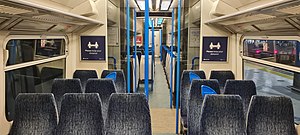
ABB Ltd. is a Swedish–Swiss multinational corporation headquartered in Västerås, Sweden, and Zürich, Switzerland. It is traded on the SIX Swiss Exchange in Zürich, the Nasdaq Nordic exchange in Sweden and the OTC Markets Group's pink sheets in the United States. It was ranked 340th in the Fortune Global 500 list of 2020 and has been a global Fortune 500 company for 24 years.

British Rail Engineering Limited (BREL) was the railway systems engineering subsidiary of British Rail.
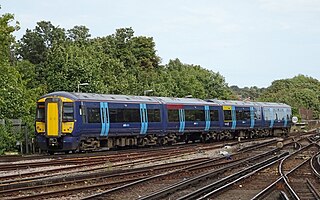
The British Rail Class 375 Electrostar is an electric multiple unit train that was built by Bombardier Transportation at Derby Litchurch Lane Works, from 1999 to 2005. The class form part of the Electrostar family of units, which also includes classes 357, 376, 377, 378, 379 and 387, the most numerous type of EMU introduced since the privatisation of British Rail.

The British Rail Class 365 Networker Express was a class of dual-voltage electric multiple unit passenger train built by ABB at Holgate Road Carriage Works in 1994 and 1995.

The London Underground 1992 Stock is a type of rolling stock used on the Central and Waterloo & City lines of the London Underground. A total of 85 eight-car trains were built for the Central line and 5 four-car trains were built for the Waterloo & City line.

The InterCity 225 is an electric push-pull high speed train in the United Kingdom, comprising a Class 91 electric locomotive, nine Mark 4 coaches and a Driving Van Trailer (DVT). The Class 91 locomotives were built by British Rail Engineering Limited's Crewe Works as a spin-off from the Advanced Passenger Train project, which was abandoned during the 1980s, whilst the coaches and DVT were constructed by Metro-Cammell in Birmingham and Breda in Italy, again borrowing heavily from the Advanced Passenger Train. The trains were designed to operate at up to 140 mph (225 km/h) in regular service, but are limited to 125 mph (200 km/h) principally due to a lack of cab signalling and the limitations of the current overhead line equipment. They were introduced into service between 1989 and 1991 for intercity services on the East Coast Main Line (ECML) from London King's Cross to Leeds, York and Edinburgh.
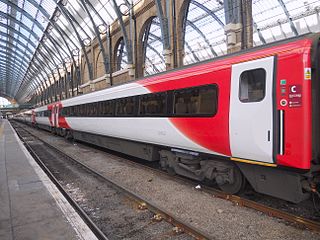
The British Rail Mark 4 is a class of passenger carriages built for use in InterCity 225 sets on the East Coast Main Line between King's Cross, Leeds and Edinburgh. Withdrawals began in 2019, with some being sold for further use with Transport for Wales between Cardiff and Holyhead.
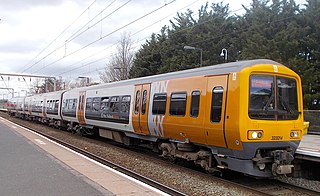
The British Rail Class 323 is a class of electric multiple unit (EMU) passenger train built by Hunslet Transportation Projects and Holec. All 43 units were built from 1992 through to 1995, although mock-ups and prototypes were built and tested in 1990 and 1991.
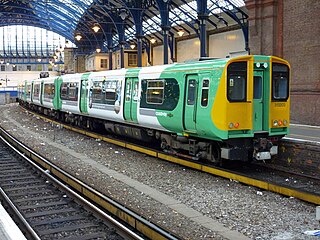
The British Rail Class 313 was a dual-voltage electric multiple unit (EMU) train built by British Rail Engineering Limited's Holgate Road carriage works between February 1976 and April 1977. They were the first production units that were derived from British Rail's 1971 prototype suburban EMU design which, as the BREL 1972 family, eventually encompassed 755 vehicles over five production classes. They were the first second-generation EMUs to be constructed for British Rail and the first British Rail units with both a pantograph for 25 kV 50 Hz AC overhead lines and contact shoe equipment for 750 V DC third rail supply. They were, additionally, the first units in Britain to employ multi-function automatic Tightlock couplers, which include electrical and pneumatic connections allowing the coupling and uncoupling of units to be performed unassisted by the driver whilst in the cab.

The British Rail Class 321 is a class of electric multiple unit (EMU) passenger train built by British Rail Engineering Limited's York Carriage Works in three batches between 1988 and 1991 for Network SouthEast and Regional Railways. The class uses alternating current (AC) overhead electrification. The design was successful and led to the development of the similar Class 320 and Class 322.

The British Rail Class 508 (4PER) was a type of electric multiple unit (EMU) passenger train built by British Rail Engineering Limited, at Holgate Road carriage works, York, in 1979 and 1980. They were a variant of British Rail's standard 1972 design for suburban EMUs, eventually encompassing 755 vehicles and five classes (313/314/315/507/508). They mostly worked on the Merseyrail network from 1982 until withdrawal on 16 January 2024.

The British Rail Class 376 Electrostar is a class of electric multiple unit passenger train that was manufactured by Bombardier Transportation at its Derby Litchurch Lane Works. It is part of the Electrostar family, which are the most common EMUs introduced since the privatisation of British Rail. The units were ordered by Connex South Eastern and introduced in 2004/2005 by South Eastern Trains to replace Class 465 and Class 466, which were transferred to Outer Suburban services to Kent to replace the Class 423 slam-door trains.
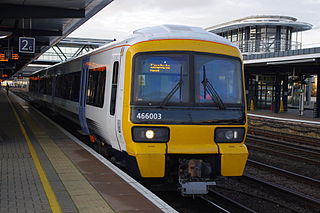
The British Rail Class 466 Networker are a fleet of 43 electric multiple units that were built by Metro-Cammell in 1993 and 1994. The units are currently operated by Southeastern.

The British Rail Class 455 is an electric multiple unit passenger train built by BREL between 1982 and 1985. It is operated on suburban services in Greater London and Surrey by South Western Railway, as well as formerly by Southern.

The British Rail Class 318 is an electric multiple unit (EMU) passenger train which operates in west central Scotland. The units were introduced on 29 September 1986 as part of the electrification of the Ayrshire Coast Line between Glasgow Central and Ayr/Ardrossan with alternating current (AC) overhead lines. Their use was extended to Largs in January 1987. They were also used on the Inverclyde Line in small numbers. The trains currently operate Argyle Line, Cathcart Circle Line, North Clyde Line, Whifflet Line and Inverclyde Line services. Following the withdrawal of the Class 314 fleet in 2019, these units are the oldest working EMUs in Scotland, having been in revenue-earning service for more than 37 years.

An electric multiple unit (EMU) is an electric self-powered train, capable of operating in multiple with other EMUs and without the need for a locomotive; these are typically passenger trains with accommodation in every vehicle and a driving position at each end. The term can also be used to describe a train that is a permanent formation with a non-driving power car, such as the Advanced Passenger Train. As of December 2010, two-thirds of the passenger carriages in Great Britain are formed in EMUs.
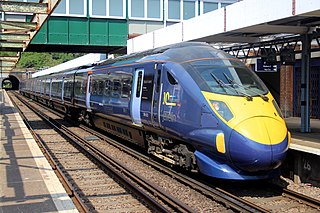
The British Rail Class 395 Javelin is a dual-voltage electric multiple unit (EMU) passenger train built by Hitachi Rail as part of the Hitachi A-train AT300 family for high-speed commuter services on High Speed 1 and elsewhere on the South Eastern franchise. The whole fleet is operated by Southeastern.

The Networker is a family of passenger trains which operate on the UK railway system. They were built in the late 1980s and early 1990s by British Rail Engineering Limited and Metro Cammell. The trains were built for the Network SouthEast (NSE) sector of British Rail, which is where their name comes from. They are all multiple-unit trains.

The Tyne and Wear Metrocars are a fleet of light rail vehicles manufactured by Metro-Cammell for the Tyne and Wear Metro in North East England between 1978 and 1981. For operation on Network Rail controlled tracks between Pelaw Junction and Sunderland, they are designated on TOPS as the Class 599. Most were refurbished between 2010 and 2015 by Wabtec Rail at Doncaster Works and are scheduled to be replaced by Class 555 rolling stock from 2024.

Network SouthEast (NSE), the sector of British Rail which ran passenger services in London and southeast England between 1986 and 1994, operated a wide variety of rolling stock during its existence. The majority of the network was electrified, and further electrification schemes took place during the 1986–1994 period; and the 7,000 vehicles owned by NSE in 1986 consisted of a mixture of electric, diesel-electric and diesel multiple units, diesel locomotives and the coaches they hauled.

